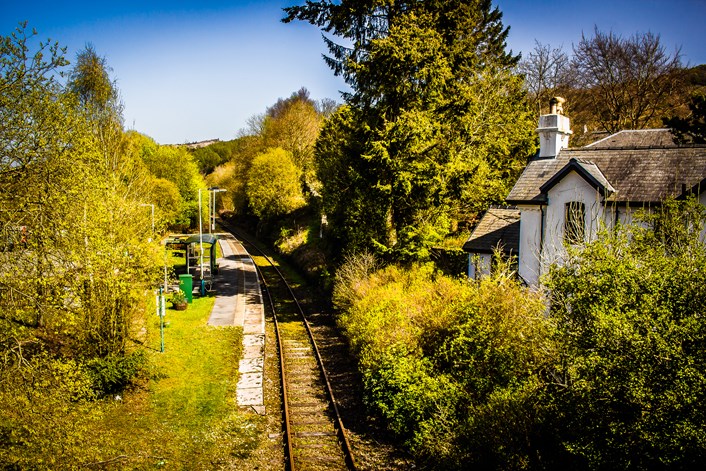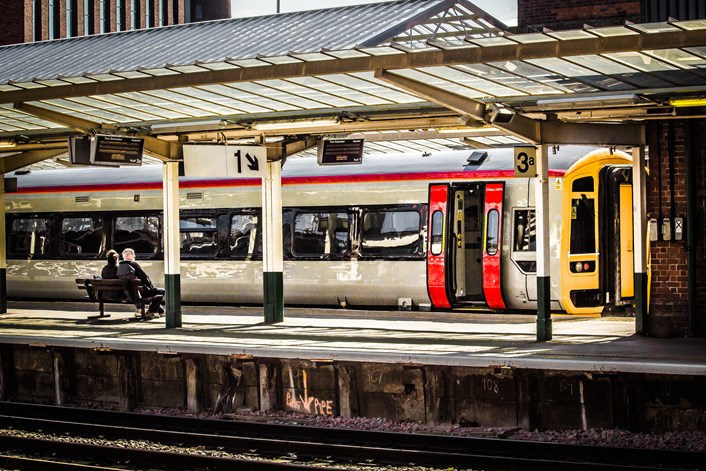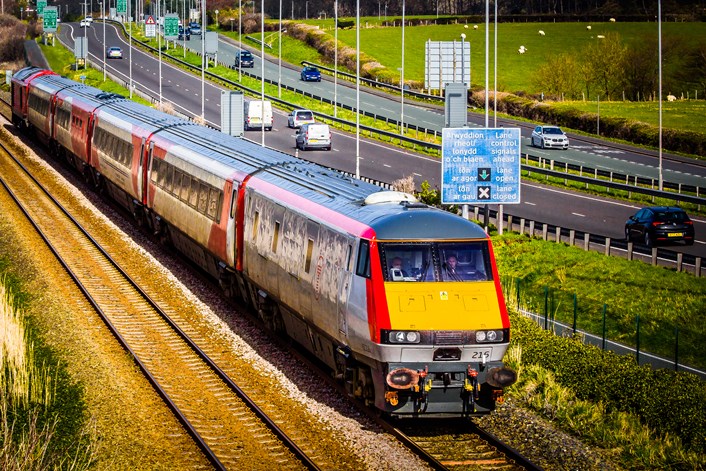07 Jun 2021
7 June marks the return of our direct services linking Cardiff Central and Holyhead, known as “Y Gerallt Gymro” or “The Gerald of Wales” service. These are operated by our Mark 4 intercity carriages and include First Class carriages, free Wi-Fi throughout, an enhanced food and drink offer including a buffet car, accessible toilets and baby changing facilities.
One of the most common questions we receive at Transport for Wales is “Why isn’t there a railway directly linking North Wales and South Wales?” The simple answer for this is that there is – it just so happens to run via England. The more complicated answer is about why there is no railway linking North and South Wales that remains entirely within Wales for its length, and this comes down to the geography and history of the nation.
Wales is a very mountainous country and is dominated by several large ranges. In North West Wales, the towering peaks of Snowdonia loom over the landscape, while the Denbigh Moors and the Clwydian Range surround North East Wales. In West Wales, the rocky Pembrokeshire coast, the Preseli Mountains and Cader Idris make for little flat ground. Mid Wales is dominated by the large mass of the Cambrian Mountains, while Mynydd Epynt and the Brecon Beacons provide barriers heading south towards the hilly South Wales valleys.
These ranges have provided major obstacles for those planning and building transport links for centuries. The difficulty in travelling through mountainous regions has kept the populations of towns and villages in rural areas low, which in turn has meant there has been little incentive for considerable investment in better transport links, perpetuating a long-running cycle.
Wales’ rural rail network
The South Wales Main Line and the North Wales Coast Line have always been Wales’ two most important rail links, but many lines have been provided through the hills and valleys. The Cambrian Railways owned a large network within Mid and North West Wales, including two lines cutting across the country, while the Central Wales Railway (now known as the Heart of Wales Line) and the Mid Wales Railway criss-crossed the country to the south. A winding route linked Carmarthen and Aberystwyth – the legacy of a failed attempt to build a direct line between Manchester and Milford Haven – while the Carnarvonshire Railway linked Bangor, Caernarfon and the Cambrian Coast Line near Porthmadog.
These were all built by individual private companies who were planning routes for their own gain – usually with the transport of freight in mind, with passengers as an after-thought. There was never a strategic national plan for a network, as seen in other European countries, who built their rail networks after Britain had led the way.
However, much of the rest of the network in rural Wales was little-used. The hilly terrain made nineteenth-century engineering incredibly challenging, which led to long, circuitous routes and slow journeys. For most people, this was the only way to travel for long distances, but in the twentieth century, this would change.
The end of rural railways
When the motor car emerged as an affordable alternative to travelling by rail, these routes suffered enormously. Due to low and falling passenger numbers and high maintenance costs, they were obvious candidates for closure when British Railways faced mounting financial losses in the 1950s.
Many towns that lost their railway connections for this reason. A good example is Brecon, which lost its rail services in 1962. These services ran to Neath, Newport, Hereford and Moat Lane Junction on the Cambrian Main Line, in patterns that were little-changed since the nineteenth century. A combination of infrequent services, low line speeds, old trains powered by steam locomotives, and many small stations serving the scattered rural communities meant journey times were very long. Journeys through the country often required multiple changes of train.
The car offered faster, more convenient journeys from door to door, while lorries offered the same opportunities for goods and freight. By the 1960s, the motor industry was seen as the future, and the railway as a relic of the past. The rural rail network throughout Britain was stripped away because it was thought rail services would never be needed again – Wales, with a higher proportion of rural railways than other parts of Britain, saw much of its network disappear. Once the tracks were lifted, the land was usually sold off, and many former rail routes were buried under roads factories and housing developments, destroying any prospect of them being reopened.
The role of the main lines
However, the main rail links did survive. Not only did the North Wales Coast and South Wales Main Lines avoid the axe, but so did the line linking the two routes. Known today as the Marches Line, the route between Newport and Chester was built in multiple stages for different purposes – the southern half was built to provide a link Newport, Abergavenny and Hereford, while the northern half was built as part of a GWR main line linking London and Birkenhead. Both routes ran through much easier terrain to build through than the mountains of Mid and North Wales, making them much more suitable to be main lines.
It is only in the decades since that the main purpose of the Marches Line has changed to become a route linking North and South Wales, as well as providing a connection between South Wales and North West England. When the rail network was being built in the nineteenth century, it was never considered that there was a need to provide a link between North and South Wales, as there was no demand for this. The North Wales Coast Line was built to provide a link between the port of Holyhead and the Grand Junction Railway between London, Birmingham and the North of England. Similarly, the South Wales Main Line was built as a link between London, Cardiff and the ports of West Wales.
As a result, North Wales looked more towards North West England for its commercial opportunities, while South Wales looked towards London. It took until well into the twentieth century for this to change, when the idea of Wales as a nation started to become more important.
North-South services
It took until the 1980s for the first Cardiff-Holyhead services to emerge, under British Rail’s Regional Railways division. One service each way ran every day, running via Crewe. The services initially used the new Class 155 Super Sprinter trains, until they were replaced in the early 1990s by the popular Class 158 Express Sprinters, providing faster, more comfortable journeys.
However, this remained a token service through the 1990s until a second service each way, running via Wrexham General, was added in 2000 by the new train operator Wales & West. When Wales & West was broken up as part of the reorganisation of Wales’ railways, new operator Wales and Borders diverted all Cardiff-Holyhead services to run via Wrexham.
It wasn’t until 2005 that Wales and Borders’ successor Arriva Trains Wales introduced the more frequent Cardiff-Holyhead service we see today, with one train every two hours. Three years later, in December 2008, came the introduction of “The Gerald of Wales”. This premium service ran once a day each way prior to being paused due to the COVID-19 pandemic. It used Mark 3 intercity carriages and featuring a dining car with a travelling chef preparing meals for those onboard, gaining it a worldwide reputation for excellent service. This will return when we reinstate on-board catering later in 2021.
What can be done to improve services?
The Welsh Government retains an aspiration to reduce journey times across the Wales and Borders network, including between North and South Wales. This is intended to be achieved by modernising the existing infrastructure, including the future electrification of the major rail routes, which will also provide additional capacity for more frequent services on them. The Welsh Government is also looking at the possibility of opening new lines to provide better links between different parts of Wales that are currently disconnected within the network, as part of their wider strategy of improving public transport connections.
However, at the present time, there are no plans to build a new route linking North and South Wales. It would be the largest infrastructure project in Wales’ history and would take decades to develop, facing many significant challenges.
Simply reinstating the former rail routes through Mid or West Wales would not be enough. The routes would not be suitable for a North-South intercity service, because their meandering nature would mean journey times would be far longer than via the current route. As well as this, the former trackbeds of these routes were sold off and redeveloped in many places, making rebuilding of the old railway almost impossible.
Alternatively, an entirely new route could theoretically run direct between North and South Wales, with fewer stops and a much straighter alignment developed for higher speeds. However, this would be even more challenging to design and build, as it would require forging a brand new route through mountainous terrain. There would have to be extensive consultation about where the route would go, and which towns would be served by it. It would have to pass through unspoilt landscapes, national parks and areas of outstanding natural beauty, and would probably require heavy engineering solutions such as long tunnels and large viaducts.
As such, the initial priority is to upgrade existing lines so that they can carry more trains and provide faster journeys, including the current North-South route via the Marches Line. Along with providing the North-South link, it has the added benefit of serving three large settlements in the borders region – Chester, Shrewsbury and Hereford – which act as major interchanges for services to North West England, Mid Wales and the West Midlands respectively.
In the short term, the introduction of high-quality intercity trains on Cardiff-Holyhead services will further strengthen links between North and South Wales. With faster journeys, more capacity and better facilities, they will provide a significant improvement in the customer experience and help us continue to build a transport network that Wales and the borders region can be proud of.










